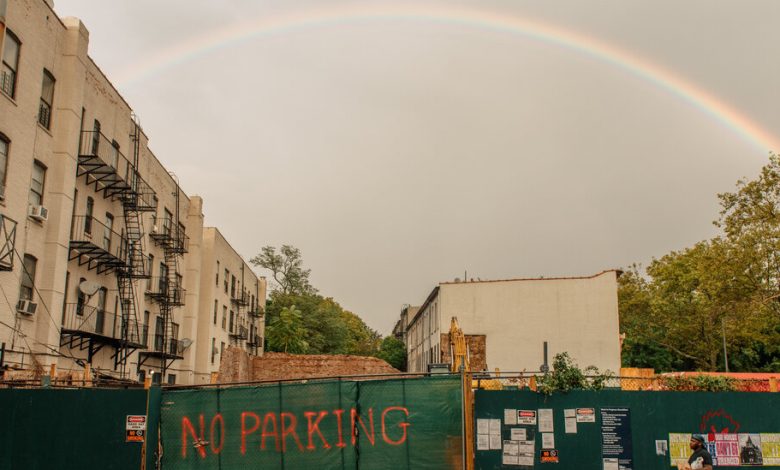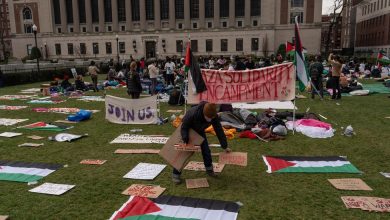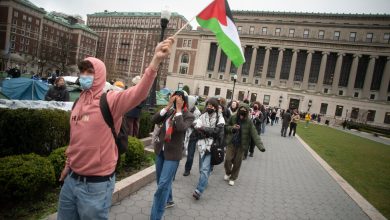A Bed-Stuy Mansion Has Become Rubble. Residents Ask: How, and Why?

To neighbors of the Jacob Dangler House in Bedford-Stuyvesant, Brooklyn, the French Gothic palatial building was a meeting space, a community center, and a place for baby showers, weddings and funeral repasts.
The mansion was built around the late 19th century and designed by the architect Theobald Engelhardt for Jacob Dangler, a prominent meatpacker, who wanted to be close to his business on Myrtle Avenue. The United Grand Chapter of the Order of the Eastern Star, a Masonic organization made up of Black women, later bought the building at 441 Willoughby Avenue. But 441, as the locals called it, is gone.
The destruction of the building in July could not be stopped, despite pleas, protests and petitions after the Masonic organization, saddled with rising debts, sold it to a developer. Requests to the city’s Landmarks Preservation Commission to grant the building official historic designation did not help. Complaints to the city’s Department of Buildings that the planned demolition was not being done correctly were ineffective. A celebrity appeal from the actor Edward Norton, who filmed part of his 2019 film “Motherless Brooklyn” at the Dangler House, went nowhere.
According to Mayor Eric Adams’s office, the developer received a permit to tear down the house through the Department of Buildings. Because of a technological glitch, the Landmarks Preservation Commission was not flagged about the permit in time to consider designating the mansion as historic.
“We have taken immediate steps to prevent such issues in the short term, and, as part of Mayor Adams’s efforts to modernize operations at city agencies, the administration is already developing a permanent technology solution that would ensure an error like this never occurs again,” the mayor’s office said in an emailed statement.
The developer, Tomer Erlich of Brooklyn 360, has previously said that “ultimately” the site is “private property.” Mr. Erlich and Brooklyn 360 did not respond to requests for comment.
The once-stately mansion is now piles of rubble, and the battle over the site’s future is yet another fight for the character of Bedford-Stuyvesant, a neighborhood still seen by many as a mecca of Black culture. But like much of Brooklyn and other parts of New York City, Bed-Stuy is in transition. The neighborhood lost 22,000 Black residents in the last decade, according to 2020 census data, and added more than 30,000 white residents.
“Within this community and this area, there are so many things happening. New buildings, buildings being torn up, green fences being built,” said Michael Williams, a lifelong Willoughby Avenue resident, referring to the fences that go up around construction sites.
Mr. Williams is something of a celebrity on the leafy block on Willoughby Avenue where the mansion once stood. A half-dozen neighbors stopped by his brownstone stoop within an hour on a sticky morning in August. Most wanted to talk about the same thing: the demolition.
But residents still want to know: How did the demolition happen so quickly, and what becomes of the site now?
These interviews have been lightly edited for clarity.
Michael Williams, Willoughby Avenue resident
I’ve been on this block all my life, OK? I’m 65. I see things are changing — it’s changing, in a way better, but not for us.
The people in the community wanted to make it a community center for repasts and weddings. We could have had our block association meetings there. It could have been a learning center for kids. It was multiple things that this building could have been if it was still here today. But now that it’s no longer there, where do the kids go? Where do the senior citizens go? Where do the people in the community go when they want to sit down, relax and just congregate with the people in the community? So right now, in this area, we don’t have any place.
[In] 1962, I was in the Cub Scouts in that building. So the Brownies and the Girl Scouts were upstairs, and the Cub Scouts and the Boy Scouts were downstairs in the basement. And on a nice day, a Saturday or weekday, we would come in the yard and sit around and just talk.
We lost the love of our people in this community, and that’s sad. We still have great people on this block, and we are going to fight. We’re going to fight to a point where we are going to make sure everything is level, and it’s right.
Lauren Cawdrey, vice president of the Willoughby Nostrand Marcy Block Association
We knew it was a neck-and-neck race here between the D.O.B. granting the demo permit and Landmarks taking a look at it. We went through all the motions of doing this, only to basically get no answer and to just get demolished anyway — and to get demolished in such a violent way, you know. There’s a proper way to demo something. The nicest thing to do would have been to call in some architectural salvage people and let them take off. Look, there’s copper roofing and gargoyles, and, you know, limestone and slate shingles. These are valuable materials — the bluestone, I’m assuming each one of those could fetch hundreds of dollars.
The whole building came down in under two hours. People, bystanders, just stopping and watching horror. And it was just very much an us-versus-them situation because here, you have neighbors and activists: We were just consoling each other and in tears, and then you have the developer and the workers cheering on every time a giant slab of debris fell down. You could hear us crying and gasping and the developers cheering and applauding. It was so violent and unsafe, and it was really traumatic.
It was just the crown jewel of a beautiful block. It was such a huge place for the community, and so many people were just blindsided.
Kendall Jinwright, teacher
At the time we booked the space [for a baby shower], it was right before the news came out about them selling. So we had the event in late September, and I guess it magically worked out because nothing worked out with any other event space we looked at.
It was a conveniently located spot, and that’s where everyone from the neighborhood has their events. I grew up on that block, so that was the first thing I would see when I entered my street.
Everyone who came from out of state was like, “Wow, this looks like a castle.” I’m happy to know, like it brings me joy to know that that’s where we celebrated the baby’s life. Right before they put the scaffolding up, we took a picture — the baby and I — in front of the temple. We just moved to Charlotte, so it’s going to go on our living room walls.
I lived through the whole change and gentrification, but that’s one of those landmarks — like everyone from the area knew the Masonic temple on Willoughby. It just played well with the brownstones on the block. They’re going to put up one of those disgusting-looking buildings they put on every corner now. It just takes away from Bed-Stuy, like the character of the block.
Chi Ossé, council member representing Bedford-Stuyvesant
What I think was lost and what has continued to be missed from the demolition — the actual action itself — is common decency and respect. As a resident of central Brooklyn and now council member that represents central Brooklyn, we’ve seen this story time and time again of developers that don’t really care about the character of a neighborhood and the services that are sometimes provided by a space like the Dangler House, and ignoring the wants and wishes of folks that lived on that block and even in the surrounding area.
They’re missing a space to congregate, a space that holds history of the neighborhood — a space that offered a space for many different community events. But from my perspective, the largest thing that was missed here and taken away from the community was respect, co-governance and community input.
We’re continuing to engage in conversations. And we’re all trying to work on solutions that our communities need.




